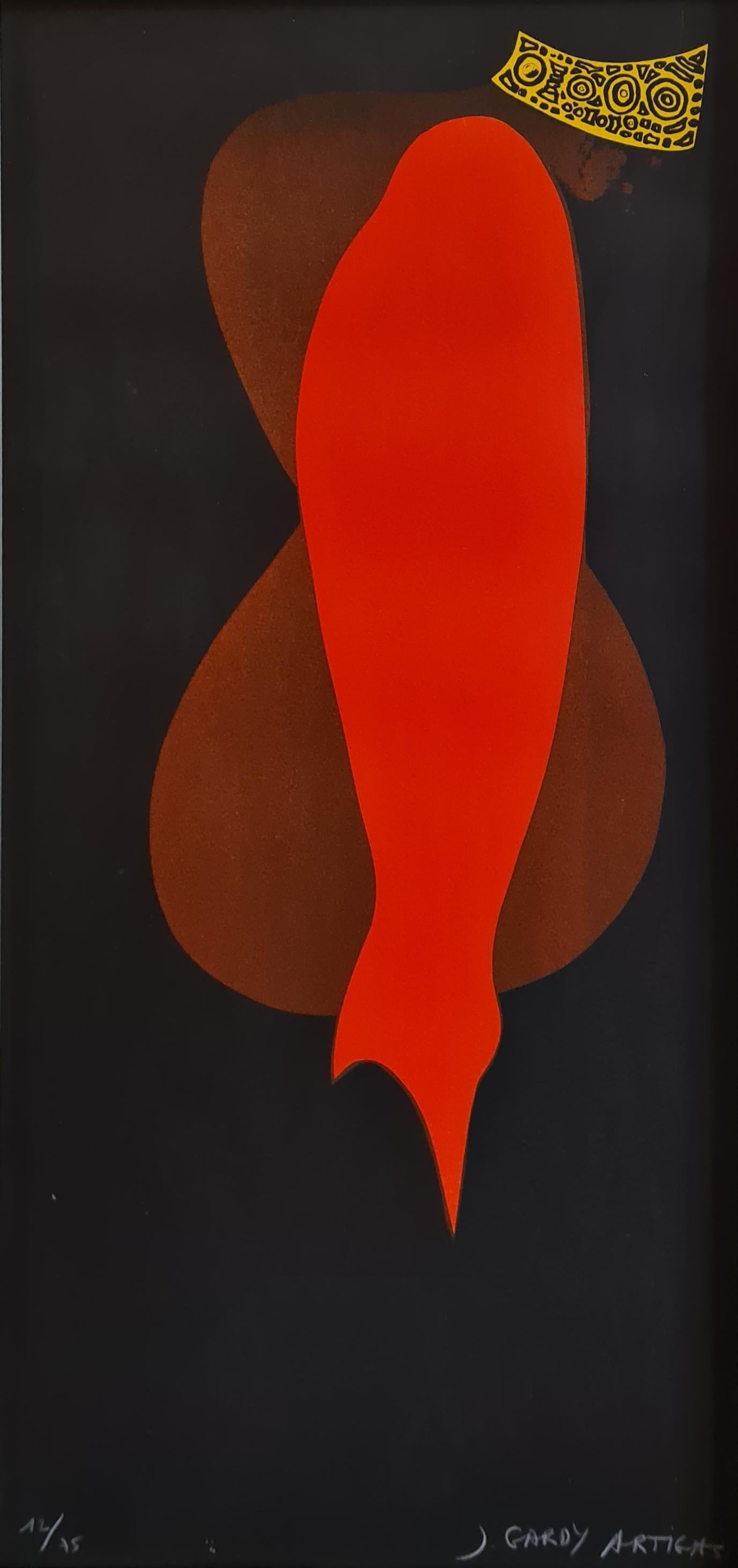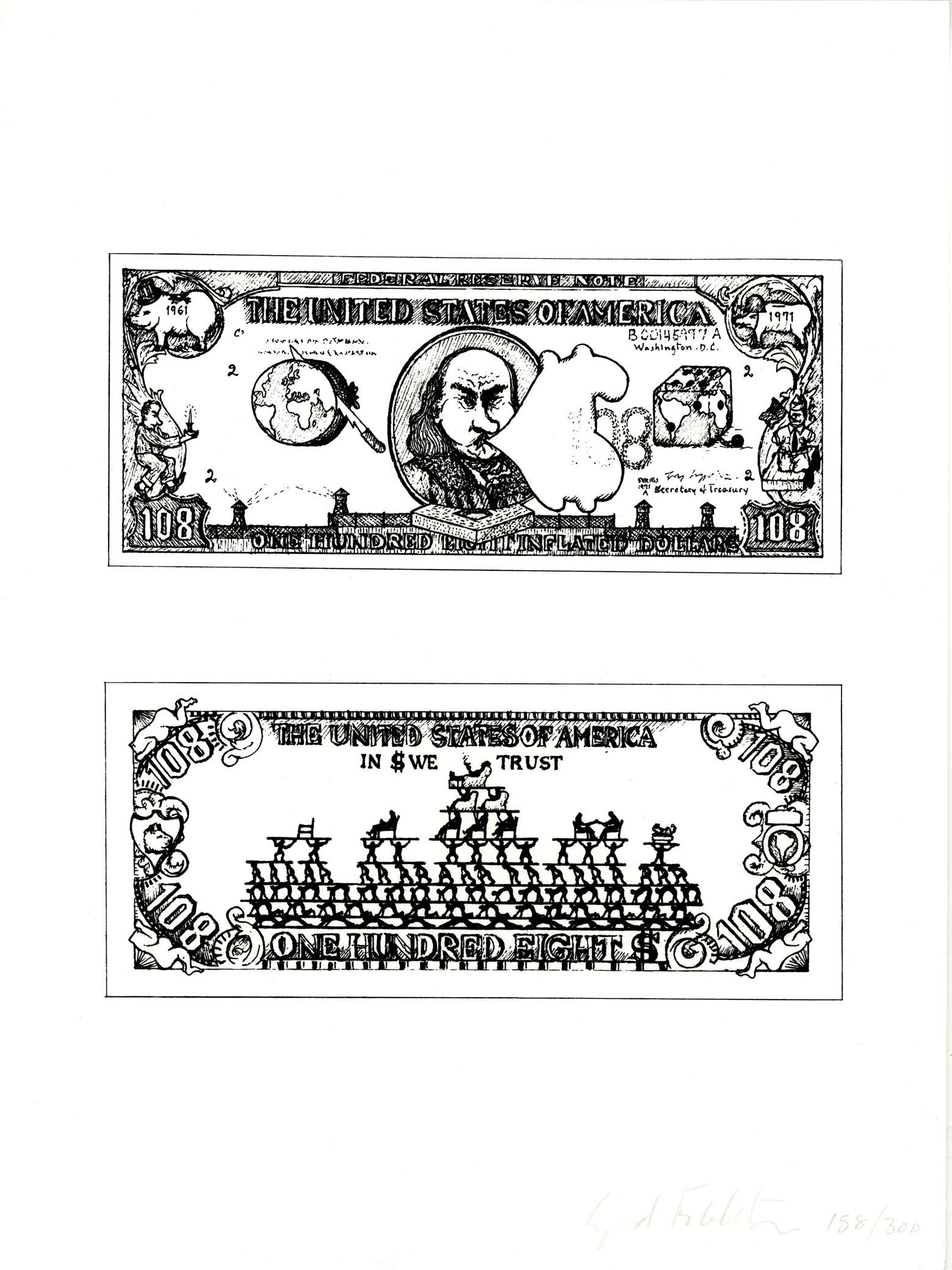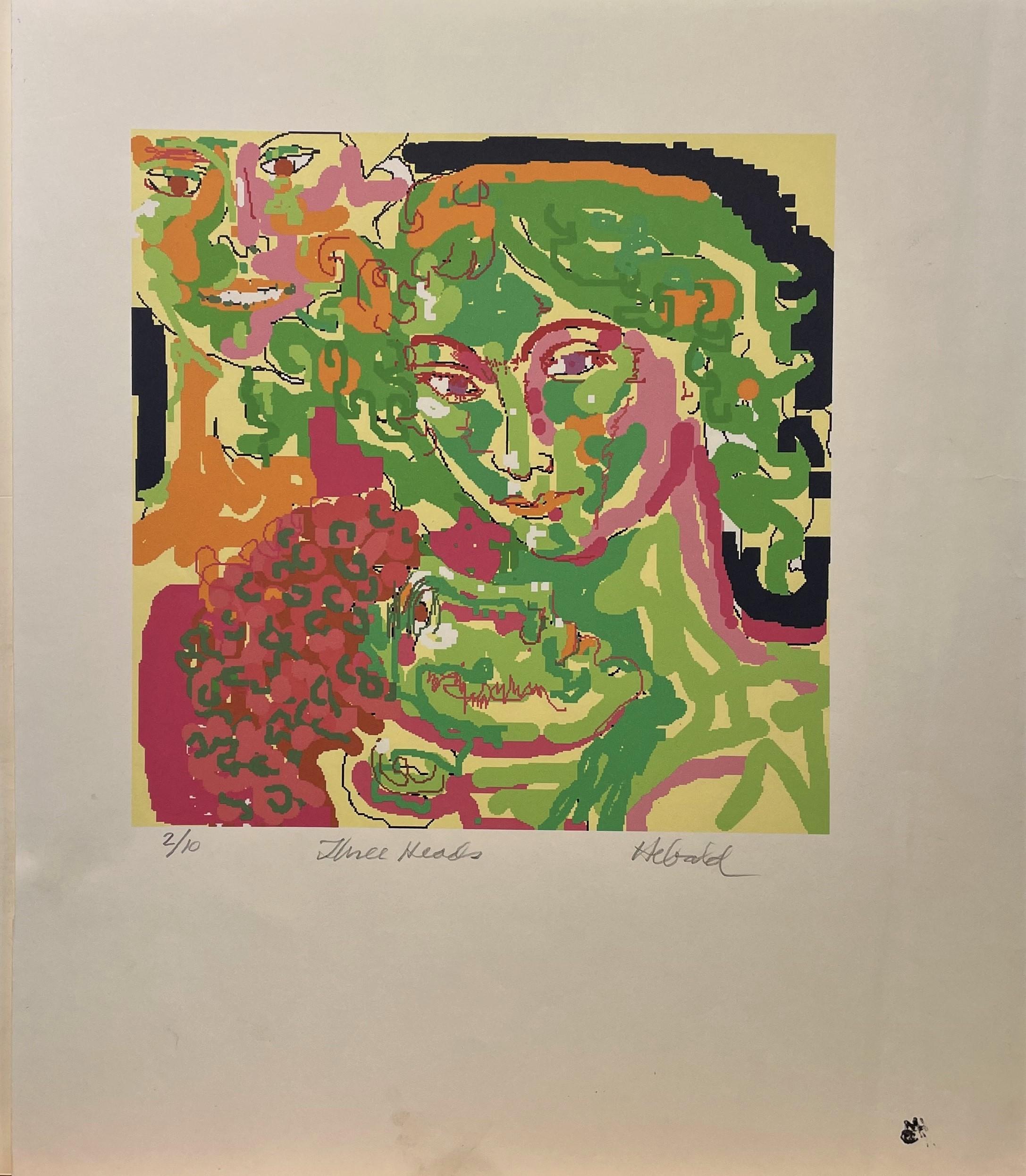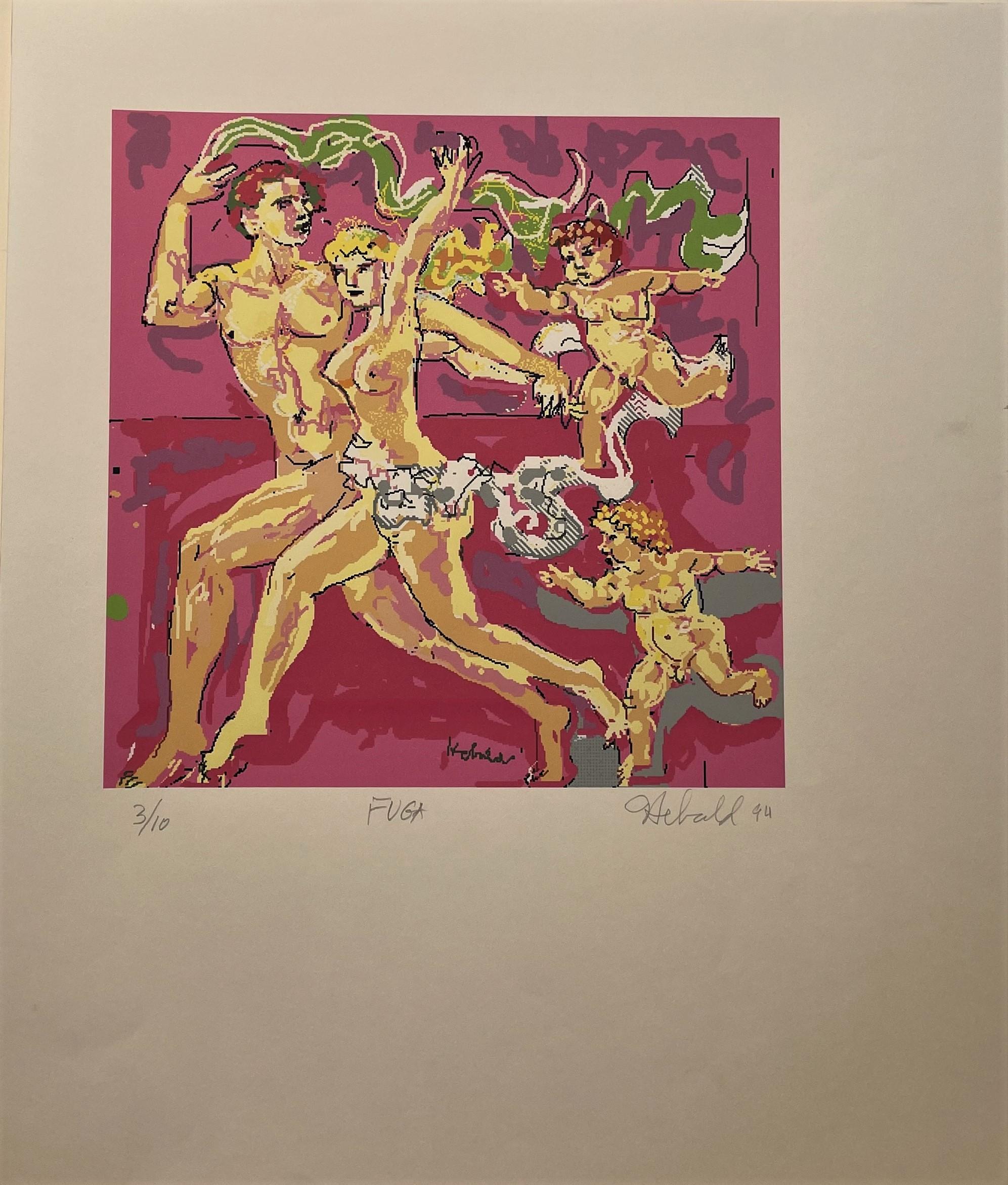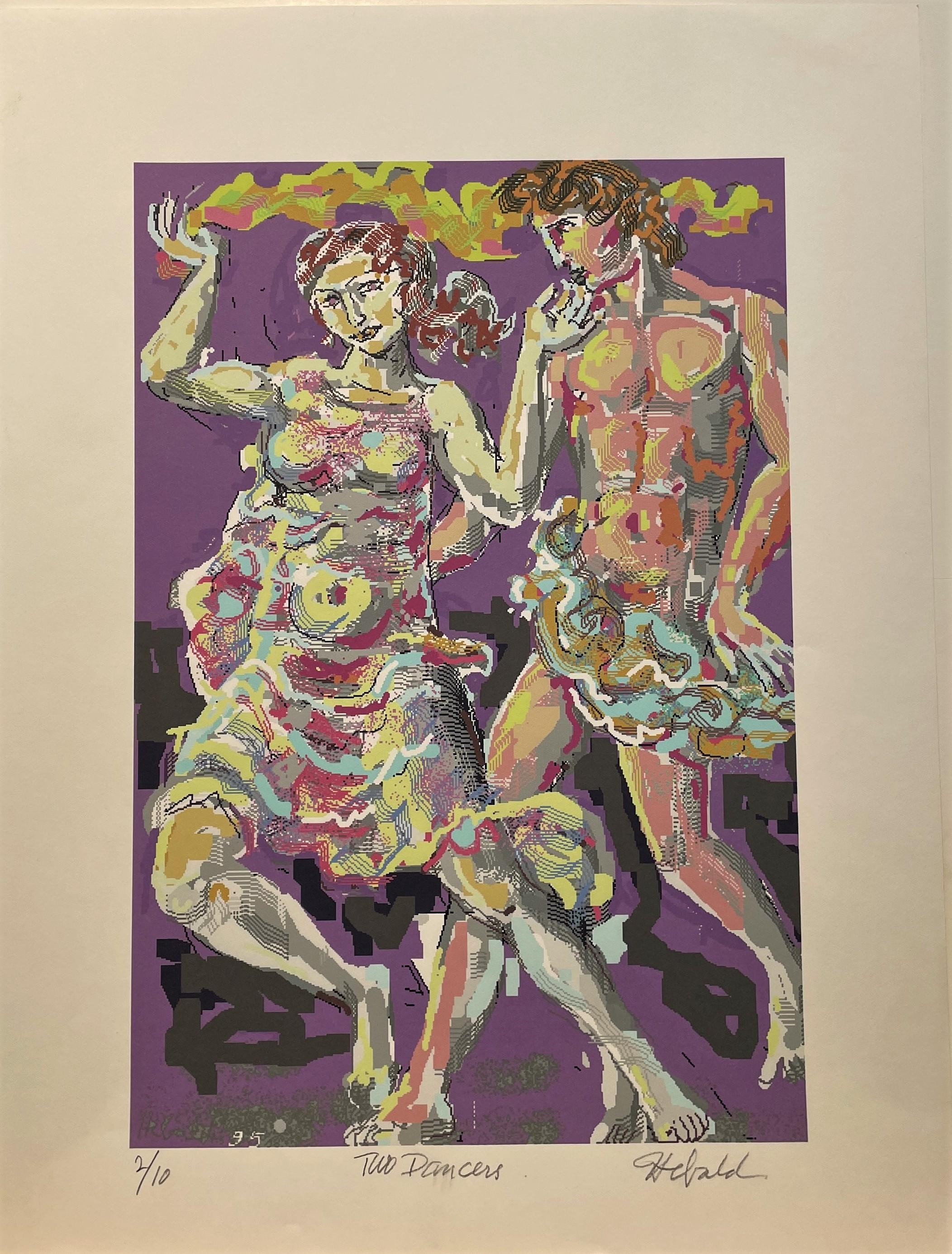Marc Chagall"Nuit d'été (Summer's Night)" Lithograph, Colors, Linear Figures on Black Ground1973
1973
About the Item
- Creator:Marc Chagall (1887 - 1985, French)
- Creation Year:1973
- Dimensions:Height: 35.75 in (90.81 cm)Width: 28.25 in (71.76 cm)
- Medium:
- Movement & Style:
- Period:
- Condition:
- Gallery Location:Detroit, MI
- Reference Number:1stDibs: LU128617339762
Marc Chagall
Described by art critic Robert Hughes as "the quintessential Jewish artist of the twentieth century," the Russian-French modernist Marc Chagall worked in nearly every artistic medium. Influenced by Symbolism, Fauvism, Cubism and Surrealism, he developed his own distinctive style, combining avant-garde techniques and motifs with elements drawn from Eastern European Jewish folk art.
Born Moishe Segal in 1887, in Belarus (then part of the Russian empire), Chagall is often celebrated for his figurative paintings, but he also produced stained-glass windows for the cathedrals of Reims and Metz, in France; for the United Nations, in New York; and for the Hadassah Hospital in Jerusalem, as well as book illustrations, stage sets, ceramics, tapestries and fine-art prints. Characterized by a bold color palette and whimsical imagery, his works are often narrative, depicting small-village scenes and quotidian moments of peasant life, as in his late painting The Flight into Egypt from 1980.
Before World War I, Chagall traveled between St. Petersburg, Paris and Berlin. When the conflict broke out, he returned to Soviet-occupied Belarus, where he founded the Vitebsk Arts College before leaving again for Paris in 1922. He fled to the United States during World War II but in 1947 returned to France, where he spent the rest of his life. His peripatetic career left its mark on his style, which was distinctly international, incorporating elements from each of the cultures he experienced.
Marc Chagall remains one of the past century’s most respected talents — find his art on 1stDibs.
- ShippingRetrieving quote...Ships From: Detroit, MI
- Return PolicyA return for this item may be initiated within 14 days of delivery.
- Larry Rivers Lithograph "For Adults Only I" Corseted Nude FemaleBy Larry RiversLocated in Detroit, MISALE ONE WEEK ONLY "For Adults Only I" is an exquisite offset lithograph print with colors of an alluring corseted and stockinged nude female in a confrontational pose filling the f...Category
1970s Pop Art Figurative Prints
MaterialsLithograph, Offset
- Arnold Singer "Woman on Arm of Sofa" Lithograph Linear Black & WhiteLocated in Detroit, MI“Woman on Arm of Sofa” is an extraordinary lithograph by Arnold Singer. You could say it is representative of his interests in several art styles that ar...Category
1960s Contemporary Figurative Prints
MaterialsLithograph
- Roy Lichtenstein Tryptich "as I opened fire" 1966 Stedelijk Museum AmsterdBy Roy LichtensteinLocated in Detroit, MISALE ONE WEEK ONLY "As I opened fire" is a lithograph triptych by Roy Lichtenstein whose provenance is printed on verso: Coll. Stedelijk Museum Amsterdam. Editions were copyrighted by the Stedelijk Museum Amsterdam and corrected with the original and printed in the Netherlands. Each piece measures: 25 1/8" h x 20 5/8" w. Roy Fox Lichtenstein was an American pop artist. During the 1960s through the 90’s, along with Andy Warhol, Jasper Johns, and James Rosenquist, he became a leading figure in the new art movement. His work defined the premise of pop art through parody. Most of Lichtenstein's best-known works are relatively close, but not exact, copies of comic book panels, a subject he largely abandoned in 1965. Lichtenstein's Still Life paintings, sculptures and drawings, which span from 1972 through the early 1980s, cover a variety of motifs and themes, including the most traditional such as fruit, flowers, and vases. Inspired by the comic strip, Lichtenstein produced precise compositions that documented while they parodied, often in a tongue-in cheek manner. His work was influenced by popular advertising and the comic book style. His artwork was considered to be "disruptive". He described pop art as "not 'American' painting but actually industrial painting". His paintings were exhibited at the Leo Castelli Gallery in New York City. Wham!, and Drowning Girl Look Mickey proved to be his most influential works. His most expensive piece is Masterpiece which was sold for $165 million in January 2017. Lichtenstein received both his Bachelors and Masters at Ohio State University, Columbus, Ohio where he taught for ten years. In 1967, he moved back to upstate New York and began teaching again. It was at this time that he adopted the Abstract Expressionist style, being a late convert to this style of painting. Lichtenstein began teaching in upstate New York at the State University of New York at Oswego in 1958. About this time, he began to incorporate hidden images of cartoon characters such as Mickey Mouse and Bugs Bunny into is abstract works. In 1960, he started teaching atRutgers University where he was heavily influenced by Allan Kaprow, who was also a teacher at the university. This environment helped reignite his interest in Proto-pop imagery. In 1961, Lichtenstein began his first pop paintings using cartoon images and techniques derived from the appearance of commercial printing. This phase would continue to 1965, and included the use of advertising imagery suggesting consumerism and homemaking. His first work to feature the large-scale use of hard-edged figures and Ben-Day dots was Look Mickey (1961), National Gallery of Art, Washington, D. C.) This piece came from a challenge from one of his sons, who pointed to a Mickey Mouse comic book and said; "I bet you can't paint as good as that, eh, Dad?" In the same year he produced six other works with recognizable characters from gum wrappers and cartoons. It was at this time that Lichtenstein began to find fame not just in America but worldwide. He moved back to New York to be at the center of the art scene in 1964 to concentrate on his painting. Lichtenstein used oil and Magna (early acrylic) paint in his best known works, such as Drowning Girl (1963), which was appropriated from the lead story in DC Comics’ Secret Hearts No. 83, drawn by Tony Abruzzo. (Drowning Girl now hangs in the Museum of Modern Art, New York.) Drowning Girl also features thick outlines, bold colors and Ben-Day dots, as if created by photographic reproduction. Of his own work Lichtenstein would say that the Abstract Expressionists "put things down on the canvas and responded to what they had done, to the color positions and sizes. My style looks completely different, but the nature of putting down lines pretty much is the same; mine just don't come out looking calligraphic, like Pollock’s or Kline’s. Rather than attempt to reproduce his subjects, Lichtenstein's work tackled the way in which the mass media portrays them. He would never take himself too seriously, however, saying: "I think my work is different from comic strips – but I wouldn't call it transformation; I don't think that whatever is meant by it is important to art.” When Lichtenstein's work was first exhibited, many art critics of the time challenged its originality. His work was harshly criticized as vulgar and empty. The title of a Life magazine article in 1964 asked, "Is He the Worst Artist in the U.S.?" Lichtenstein responded to such claims by offering responses such as the following: "The closer my work is to the original, the more threatening and critical the content. However, my work is entirely transformed in that my purpose and perception are entirely different. I think my paintings are critically transformed, but it would be difficult to prove it by any rational line of argument.” In 1969, Lichtenstein was commissioned by Gunter Sachs to create Composition and Leda and the Swan, for the collector's Pop Art bedroom suite at the Palace Hotel in St. Moritz. In the late 1970s and during the 1980s, Lichtenstein received major commissions for works in public places: the sculptures Lamp (1978) in St. Mary's, Georgia; Mermaid (1979) in Miami Beach; the 26 feet tall Brushstrokes in Flight (1984, moved in 1998) at John Glenn Columbus International Airport; the five-storey high Mural with Blue Brushstroke (1984–85) at the Equitable Center, New York and El Cap de Barcelona (1992) in Barcelona. In 1994, Lichtenstein created the 53-foot-long, enamel-on-metal Times Square Mural in Times Square subway station. In 1977, he was commissioned by BMW to paint a Group 5 Racing Version of the BMW 320i for the third installment in the BMW Art Car Project. The DreamWorks Records logo was his last completed project. "I'm not in the business of doing anything like that (a corporate logo) and don't intend to do it again," allows Lichtenstein. "But I know Mo Ostin and David Geffen and it seemed interesting. In 1996 the The National Gallery of Art in Washington, D.C. became the largest single repository of the artist's work when Lichtenstein donated 154 prints and 2 books. The Art Institute of Chicago has several important works by Lichtenstein in its permanent collection, including Brushstroke with Spatter (1966) and Mirror No. 3 (Six Panels) (1971). The personal holdings of Lichtenstein's widow, Dorothy Lichtenstein, and of the Roy Lichtenstein Foundation number in the hundreds. In Europe, the Museum Ludwig in Cologne has one of the most comprehensive Lichtenstein holdings with Takka Takka (1962), Nurse (1964), Compositions I (1964), besides the Frankfurt Museum fur Modern Kunst with We Rose Up slowly (1964), and Yellow and Green Brushstrokes...Category
1960s Pop Art Figurative Prints
MaterialsLithograph
- "History of Detroit" Linoleum Cut, Black Ink, African American, Mural StyleBy Hubert MasseyLocated in Detroit, MI"History of Detroit" is in the style of a mural by the master muralist from the city of Detroit, Hubert Massey. It renders in dramatic composition the ov...Category
Early 2000s American Modern Figurative Prints
MaterialsLinocut
- Axel Crieger Audrey Hepburn Fotocollage Print "Fragility Adored" Ltd EdBy Axel CriegerLocated in Detroit, MISALE ONE WEEK ONLY "Fragility Adored" a Fotocollage print on photographic paper by Axel Crieger (1955 - ) of an Audrey Hepburn publicity photo for "Sabrina" now placed in a cafe. I...Category
1950s Conceptual Figurative Prints
MaterialsPhotographic Paper
- Antonio Lopez Saenz Aquatint "Hombres y Sillos" (Men and Chairs)By Antonio Lopez Saenz 1Located in Detroit, MISALE ONE WEEK ONLY Antonio Lopez Saenz is a brilliant iconic creative artist from Mazatlan, Mexico. The aquatint “Hombres y Sillos” (Men and Chai...Category
1980s Contemporary Figurative Prints
MaterialsAquatint
- 'Chamonix' Mid-Century Hand Signed Original Lithograph.By Joan Gardy ArtigasLocated in Cotignac, FRMid-Century original lithograph entitled " Chamonix " hand signed by Joan Gardy Artigas and numbered 12/75 on arches vellum rag paper from the 1966-70 edition. Presented in period 19...Category
Mid-20th Century Modern Figurative Prints
MaterialsPrinter's Ink, Rag Paper, Lithograph
- One Hundred and Eight Inflated Dollars, from Sonnabend and Castelli CollectionBy Oyvind FahlstromLocated in New York, NYÖyvind Fahlström One Hundred and Eight Inflated Dollars, from the Collection of Ileana Sonnabend and the Estate of Nina Castelli, 1973 Lithograph on rag paper. Signed. Numbered. in o...Category
1970s Contemporary Figurative Prints
MaterialsRag Paper, Lithograph
- Three HeadsLocated in Santa Fe, NMMILTON HEBALD (1917 - 2015) In 1994, at 77 years, Milton Hebald, one of the pre-eminent American figurative sculptors of the 20th centur...Category
1990s American Modern Figurative Prints
MaterialsRag Paper, Digital, Digital Pigment
- FUGALocated in Santa Fe, NMMILTON HEBALD (1917 - 2015) In 1994, at 77 years, Milton Hebald, one of the pre-eminent American figurative sculptors of the 20th centur...Category
1990s American Modern Figurative Prints
MaterialsDigital Pigment, Rag Paper, Digital
- Budding GroveLocated in Santa Fe, NMMILTON HEBALD (1917 - 2015) In 1994, at 77 years, Milton Hebald, one of the pre-eminent American figurative sculptors of the 20th centur...Category
1990s American Modern Figurative Prints
MaterialsRag Paper, Digital, Digital Pigment
- Two DancersLocated in Santa Fe, NMMILTON HEBALD (1917 - 2015) In 1994, at 77 years, Milton Hebald, one of the pre-eminent American figurative sculptors of the 20th centur...Category
1990s American Modern Figurative Prints
MaterialsRag Paper, Digital, Digital Pigment
